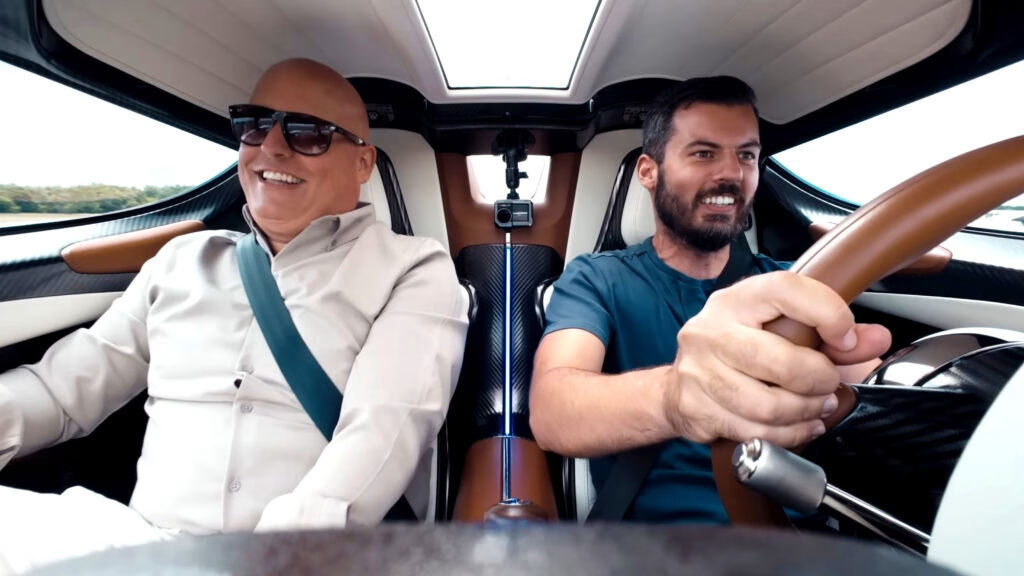What Happens When Hypercar Legends Swap Cars on the Track?
Imagine the scene: three of the world’s most influential sports car visionaries—Mate Rimac, Christian von Koenigsegg, and Rob Dickinson—gathering at the legendary Top Gear test track. Not for a polite chat over coffee, but to push each other’s prized machines to their absolute limits. Yes, it’s every car enthusiast’s dream come true, and for these industry titans, it’s a rare chance to step into the driver’s seat of their rivals’ masterpieces.
Why Do Rival Hypercar Bosses Respect Each Other So Much?
On paper, Rimac and Koenigsegg are fierce competitors. Both have spent years chasing world records, trading blows in the relentless pursuit of speed, technology, and innovation. But scratch beneath the surface, and you’ll find a deep mutual respect. It’s not just about who’s faster or who has the most patents—it’s about admiration for the sheer audacity and creativity each brings to the table.
When Top Gear invited them to drive each other’s cars, the excitement was palpable. Rimac, known for his electric hypercar wizardry, was genuinely curious about Koenigsegg’s mechanical marvels. Koenigsegg, in turn, couldn’t wait to sample the instant torque and futuristic feel of Rimac’s Nevera. And then there’s Rob Dickinson, the mastermind behind Singer, whose reimagined Porsche 911s have become the stuff of legend among collectors. While Singer doesn’t build hypercars in the traditional sense, their craftsmanship and attention to detail put them in the same league—at least when it comes to desirability and price tags.
What Makes the Koenigsegg CC850’s Gearbox So Revolutionary?
Let’s talk about the Koenigsegg CC850. This isn’t just another hypercar—it’s a rolling showcase of mechanical ingenuity. The star of the show? Its unique transmission. At first glance, it’s a classic gated six-speed manual, the kind that makes purists weak in the knees. But here’s the twist: flip a switch, and it transforms into a nine-speed automatic. No, that’s not a typo.
Mate Rimac was first to jump behind the wheel. Used to the seamless surge of electric power, he was fascinated by the tactile, old-school feel of the CC850’s gearbox. He didn’t just cruise around, either—he drove it like he’d stolen it, eager to see how far he could push the limits. The verdict? He was blown away by the analog connection and the sheer cleverness of the engineering.
Rob Dickinson, too, couldn’t resist the CC850’s charm. For someone who’s spent years perfecting the art of the manual transmission in Singer’s 911s, the Koenigsegg’s dual personality was a revelation. It’s the kind of innovation that makes you rethink what’s possible in a modern supercar.
How Does the Singer DLS Stack Up Against True Hypercars?
You might wonder how a Singer 911 DLS fits into a lineup with the likes of the Bugatti Mistral and Rimac Nevera. The answer is simple: driving pleasure. While the DLS doesn’t chase top speed records, it delivers a visceral, analog experience that’s become increasingly rare in today’s digital age.
Both Christian von Koenigsegg and Mate Rimac took the DLS for a spin. The feedback was glowing—especially from Rimac, who openly admitted he’d already placed an order for his own. That’s high praise from a man whose day job involves building some of the fastest electric cars on the planet. The Singer’s transmission, balance, and sense of occasion left a lasting impression, proving that you don’t need four-figure horsepower to create magic on the road.
What Sets the Bugatti Mistral and Rimac Nevera R Apart?
Of course, no hypercar showdown would be complete without a Bugatti. The limited-run Mistral brought a touch of French flair and raw power to the party. Christian and Mate both took turns behind the wheel, savoring the effortless acceleration and luxury that only a Bugatti can deliver.
Then came the Rimac Nevera R. If the CC850 and DLS are about emotion and engagement, the Nevera is about mind-bending speed. It’s a different kind of thrill—one rooted in the instant, relentless force of electric propulsion. While Rimac himself admits it doesn’t tug at the heartstrings in quite the same way as a manual gearbox, there’s no denying the Nevera’s ability to warp your sense of reality in a straight line.
What Do These Test Drives Reveal About the Future of Supercars?
Watching these industry leaders swap cars isn’t just entertaining—it’s a glimpse into the future of high-performance motoring. Each car represents a different philosophy: Koenigsegg’s blend of analog and digital, Singer’s homage to the golden age of sports cars, Bugatti’s pursuit of luxury and speed, and Rimac’s electric revolution.
What’s striking is how much these bosses appreciate each other’s work. There’s no sneering at different approaches—just genuine curiosity and admiration. It’s a reminder that innovation doesn’t happen in a vacuum. The best ideas often come from cross-pollination, from stepping outside your comfort zone and experiencing something new.
If You Could Drive Just One, Which Would It Be?
Tough question, right? Would you go for the analog purity of the Singer DLS, the technical wizardry of the Koenigsegg CC850, the effortless power of the Bugatti Mistral, or the futuristic punch of the Rimac Nevera R? Each offers a unique flavor, and honestly, there’s no wrong answer.
The big takeaway? The world of hypercars isn’t about perfection—it’s about smarter adjustments and bold ideas. Start with one change this week, whether it’s seeking out a new driving experience or just appreciating a different perspective, and you’ll likely spot the difference by month’s end.

